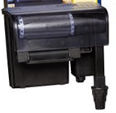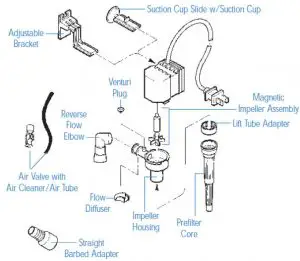
View On Amazon
| Size | Dimensions | Tank Size | Noise Level | Longevity | Price |
| 145 GPH | 2″ x 4″ x 3.75″ | 10-20 Gallons | Low | 1-3 Years | Low |
| 170 GPH | 2″ x 4″ x 4″ | 15-25 Gallons | Low | 1-3 Years | Low |
| 300 GPH | 2″ x 4″ x 4″ | 25-40 Gallons | Low | 1-3 Years | Low |
The Marineland Penguin powerhead is a mixture of powerhead and filter equipment. Many aquarists will set up under gravel filters using these powerheads, while others will still use them as a pure powerhead. If you want water flow and not the filter functionality, you should really hop over to the Marineland Maxi Jet Review.
Set-up
Setting up the Penguin powerhead is a quick and easy process, as it only has one real set up method. The long grate or prefilter goes on the bottom while the flow diffuse is generally put on the outlet. If however you want maximum flow you should skip the diffuser. The powerhead is fairly small, meaning you can place it virtually anywhere in the tank and have it go unnoticed.
To use this as an under gravel filter you will need to lower the powerheads filter into the gravel. This pulls water through the gravel, trapping debris in the gravel and making it easy to remove during water changes. You may also set up the Penguin as a sponge filter by simply covering the intake with filter floss or a filter sock. I prefer this method, as under gravel filters are a fairly dated method.
Remember the filter will be undergoing plenty of stress when sued as a filter. For this reason it is essential to keep it clean, inside and out. If you do use it as a powerhead only it will not get dirty very quickly.
Additionally there is a small tube on the top of the output. This is for air injection, which shoots a steady stream of bubbles into the tank, drastically increasing aeration. For marine tanks I highly advise against this, as it will increase salt creep dramatically, but freshwater tanks whom have air stones should definitely take advantage of this feature. It will remove the need for an air pump, reducing the electric bill each month while also getting rid of the noisiest tank component.
A final set-up note is the attachment method. When used as a powerhead you will be relying solely on the suction cup, which in this case is fairly weak. If you are having problems with a weak suction cup I always suggest the heat trick. This is where you heat up the suction cup just before putting it underwater and against the glass. As the suction cup cools, it and the air underneath it will contract, forming a much stronger seal. A word of warning, this will make the suction cup a bit difficult to remove.
Operation Notes
Because this is a smaller filter that operates via impeller rather than propeller, there is rarely any noise produced by the powerhead. However with the under gravel filter option, the impeller is much more likely to get dirty and clogged. This can create a bit of noise or stop the impeller completely.
The water is directed out of a small tube opening, which does two things. First off it focuses the water flow into one spot, creating a powerful jet of water flow rather than a wide spread that most powerheads do. This can be used to great effect for pure, horizontal water flow. The second thing the tube style output does is it prevents all fish from coming near the impeller. To do so they would need to swim directly into the current.
A common issue had with other powerheads that does not occur with the Marineland Penguin powerhead is running in reverse. In fact running in reverse used to be a feature of this powerhead that was later discontinued. This removes any and all fears of fish safety from the powerhead.
Assembly

The penguin comes apart with minimal effort. To open it simply hold the square motor compartment while turning and pulling down on the long grate that extends from the bottom of the powerhead. It should come off fairly easy, so please refrain from using excessive force, as this can snap the plastic.
Once you have the powerhead taken apart you can clean the insides of the plastic as well as the impeller itself. By keeping the powerhead clean you will restore any lost power while also improving the lifespan of the powerhead.
Flow & Adjustments
To direct the flow of the powerhead you can either
a.) Install the flow diffuser
b.) Rotate the entire powerhead
When using the powerhead as an under gravel filter the second is simply not possible. This means the flow diffuser will likely be your only method of directing the flow. This can be turned up or down, which really allows 360 degree control if you are willing to keep reattaching it to turn it.
The flow rate described matches the real flow rate, which is to be expected as this is a Marineland product. The range of power on this model is fairly low however, only covering 145-300GPH. Much more power is probably not suited to an under gravel filter anyways. This however means the Penguin should not be used as your main source of water flow unless you have slow swimming fish. It does however make an excellent supplementary powerhead that can be placed right on the substrate.
Warranty & Lifetime
The lifetime of the Marineland Penguin is a bit shorter than the Maxi-jet due to its frequent use an an under gravel filter. When used constantly you can expect the Penguin to last anywhere from 1-3 year. If you keep the impeller clean it shifts more to 2-3 years. Given the low price point on this powerhead, the lifetime and functionality is fairly high. Again if you want just flow this probably isn’t the right powerhead for you.
The warranty provided by Marineland is a solid two years, and they really stand behind their products. The customer service team and engineers are no stranger to one another, as they will frequently discuss customer issues and help resolve any problems you have. Simply contact them and be thorough on your explanation.